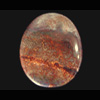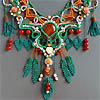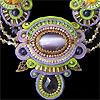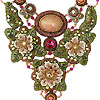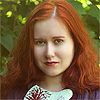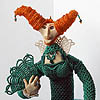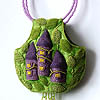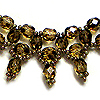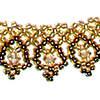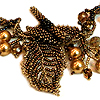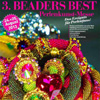July, 2013

From MyLovelyBeads.com TeamFeel the hot sun turning your skin red, hear the insects fill the night with noise, smell the rain of a summer storm, relive summer family vacations! In the current issue:
Petrified wood
Contact us with any questions at
info@mylovelybeads.com.
Fashion Colorworks 2013. Results Fashion Colorworks. Interview with Tatiana Mankova Fashion Colorworks. Interview with Miriam Shimon Fashion Colorworks. Interview with Ksenia Krutikova Beaders Best Art Fair 2013 August upcoming events Best regards,
MyLovelyBeads.com Team |
Petrified wood"Petrified wood" (from the Greek word PETRO for "rock" or "stone") literally means "wood turned into stone". It's the name given to a special type of fossilized remains of tree or tree-like plants having completely transitioned to stone by the process in which mineral deposits form internal casts of organisms. Carried by water, these minerals fill the spaces within organic tissue. All the organic materials have been replaced with minerals (mostly a silicate, such as quartz), while retaining the original structure of the stem tissue in all its detail, down to the microscopic level. Structures such as tree rings and the various tissues are often observed features. The petrifaction process occurs underground, when wood becomes buried under sediment and is initially preserved due to a lack of oxygen. In general, stem tissue takes less than one thousand years to petrify. Different elements in the water/mud during the petrification process give petrified wood a variety of color ranges: carbon - black, cobalt - green/blue, chromium - green/blue, copper - green/blue, iron oxides - red, brown, and yellow, manganese - pink/orange, manganese oxides - blackish/yellow. Petrified wood sites in the USA include: Petrified Wood Park in Lemmon (South Dakota), Petrified Forest National Park (Arizona), Petrified Forest (California), Mississippi Petrified Forest in Flora (Mississippi), Florissant Fossil Beds National Monument near Florissant (Colorado), Yellowstone National Park (Wyoming), The south unit of Theodore Roosevelt National Park outside Medora (North Dakota), Gilboa Fossil Forest (New York), Escalante Petrified Forest State Park (Utah), Petrified Springs in Kenosha (Wisconsin). Artificial petrified wood has been produced in a Washington laboratory. In the process small cubes of pine are soaked in an acid bath for two days, then in a silica solution for another two. The product is then cooked at 1400 grades of Centigrade in an argon atmosphere for two hours. The result was silicon carbide ceramic which preserved the intricate cell structure of the wood. |
||||||
Fashion Colorworks 2013. ResultsSo, the Fashion Colorworks 2013 Beading Contest, which is held this year for the fourth time, finished. This year 108 participants from 22 countries submitted 176 entries. That is slightly less than last year, but the level of the presented beadworks was so high that long before the end of the competition it became clear that we will face another success! And let the contest prizes went only to a few participants, we believe that all of you are the winners! We are grateful to the bead artists for their hard creative work, the members of the jury for its fair assessment, sponsors for the prizes, and all the fans and MyLovelyBeads.com visitors for the fact that each of them in its own way contributes to the development of bead art. THANK YOU to all of you! Let our contest be a holiday for lovers of beads! We look forward to seeing you all in 2014, and there is no doubt that the next competition will open up new names and will be another success! Today we begin featuring Fashion Colorworks 2013 winners. Of course we start with the First Place Winners. You have a chance to know Tatiana Mankova (BEADED JEWELRY), Miriam Shimon (FINISHED JEWELRY) and Ksenia Krutikova (Beaded Objects And Accessories). Have fun! |
||||||
Fashion Colorworks. Interview with Tatiana Mankova1. Why are you and other bead artists often jokingly called "bead maniacs"? In every joke there is a bit of joke! Probably because we don't only believe that the beads is a universal "designer", but also can "play" with beads for hours for many years running. In my opinion, this is one of the best games in the world! 2. When and how did you get hooked on beading? What inspired you? Something about a quarter-century ago, around the mid to late eighties. It all started with an article about beading in an old grandfather's "Science and Life" magazine issue released in 1970s. There was a pattern of a simple beaded collar, photographs of the on-loom woven ethnic necklace and peyote stitched leaves, and beaded beads. I really wanted to make such beauties and found loose Bohemian beads from my mother's old necklaces, and rough beads tucked in a vase in a closet. So, first I created a collar using the pattern from that magazine, then I made a necklace based on what I saw there, and then I could manage to weave the leaves in peyote stitch. I even started designing my own flowers and other ornaments from the remnants of beads... That time I was upset because more or less quality beads was available almost nowhere, and I begged unnecessary and torn beaded things from my friends, and each such a "catch" was a holiday opening new opportunities to create something new. 3. If this "constructor" is universal, so... Yes, it can be used to create everything or almost everything, you need just a little ingenuity, enough time and appropriate beads. Now I work not only with beads, plain tiny glass round things with small holes, but with paint and fabric, and clay, and the dreams of volume puzzles and colorworks become true. The real magic! 4. What kind of beads do you use in your works? Any which is on hand. Today's abundance of materials available for every kind of beadwork just seems like a fairy tale. Now many weavers ignore non-expensive beads of Chinese, Taiwanese and Indian production, and some consider Czech beads to be too simple, and ask Japanese ones. In fact, even the ugliest beads can be used if you treat its disadvantages as its merits. After all, these are the same pieces of smalt - only with a tiny hole. Sometimes an artist needs a fairly large spread of shapes and sizes in contrast to smooth, clear and unified but more expensive beads, or to change a shape and/or a texture of a bead item. Besides, such beads can be used to stuff beaded figures - the same way as felt artists do the wool remnants.
Full interview with Tatiana Mankova
|
||||||
Fashion Colorworks. Interview with Miriam Shimon1. Last year you won BEST USE OF COLOR award. What did you dream about this year? To be honest, I just hoped to be among the finalists but wasn't expecting to win anything. It was a huge honor for me to win the Color Prize last year and first place this year. I feel incredibly honored and thankful; it was certainly beyond anything I had dreamed about! 2. What do you think of 2013 contest beadworks level? I think that this competition, as well as other competitions this year, has shown an increased sense of adventure and exploration of boundaries within conventional bead work. The ideas and techniques are constantly evolving and I think that is what is so inspiring about participating in these competitions, pushing us to the limit and beyond, reinventing as we go along. I can't wait to see what everyone will come up with next year! 3. What would you say about the contest procedures? Very interesting and fair. The fact that the names are not revealed until after the voting is done is very refreshing. It gives a lot of freedom to both the artist and to the voting public, and personally it's an aspect I find very fascinating. 4. Which bead contests do you consider to enter next year? It really depends on how much time I have to throw myself into these very time consuming projects. The contests on my radar would probably be Bead Dreams, the Fashion Color competition and the British Bead Awards since I'm quite fond of those but it really all depends on time and inspiration, usually it's a decision I make last minute since I work best under pressure! 5. You're a well-known artist for your seed bead works, now you design soutache jewelry. Is there any reason for that switch? I don't regard this as having made a switch. I started in beadwork and it is still my big passion. Soutache is a recent addition and something I'm absolutely in love with but it doesn't come in exchange of bead work, rather as an addition. I like to switch things up and try out new things; soutache has been a good way of expressing my artistic point of view. You may say that I'm in my "soutache phase" at the moment... but I expect that will evolve too and I will find a new way of expressing myself in the future. 6. Who inspired you to make soutache embroidery and why? I first came across soutache embroidery on some Russian websites a few years ago and I really loved the idea of combining textiles with beads. At the time it was quite a rare art form and not a lot of material was available, there weren't many tutorials around or books to learn from, so it pretty much ended up being me with some beginner tutorials and a bunch of soutache threads making a bit mess before I figured out how it worked best for me. I worked on soutache on and off for about 2 years before I decided to sit down and master it in earnest. Today there are many aspiring soutache artists and a lot of wonderful jewelry out there. The more, the merrier!
Full interview with Miriam Shimon
|
||||||
Fashion Colorworks. Interview with Ksenia Krutikova1. How did you know about Fashion Colorworks contest? Why did you decide to participate? I found information about the contest on one of the Russian-speaking forums. I decided to participate because I wanted to try my hands at something serious and widespread. The idea with color triads seemed to me a very interesting. 2. What was the contest color combination you found most difficult to execute? It was most difficult to combine the colors harmoniously for the second triad because the colors included in the triad were not my favorites. But I let my imagination run wild in the first and third combinations! 3. What result of the competition did you expect? I felt that my works would be competitive, but did not expect such a success. It seemed to me that some of my work is very specific, and my beadworks are not understood by a wide range of people (this includes, first of all, jewelry). 4. What did you feel when you learned about your double win? A feeling of complete fulfillment of dreams and fortune. The joy and delight, because I proved first of all to myself that I can make something special. The desire to create and a flight of fancy. 5. Your works have unusual selection of materials, why? I'm an experimentalist by nature; I always want to try something new. I want to break stereotypes and show people things from other unusual sides. I want to inspire others to new inventions. 6. Have you ever tried other types of crafting? Oh, yes, I have tried many different types of craftwork in my life. I was engaged in knitting and embroidery, molded from clay, made straw weaving and felting. I didn't make any success only in sewing.
Full interview with Ksenia Krutikova
|
||||||
Beaders Best Art Fair 2013The third Beaders Best Bead Art Fair will take place in three weeks in Hamburg, Germany (Google map). The exhibition center is air-conditioned and has a lot of space and provides different services. The workshops will begin on August 23. International artists, manufacturers, retailers and beading friends from all over Europe and Overseas will meet at this unmatched event for the third time. The show schedule includes intensive jewelry making program, the classes will be taught by internationally recognized bead artists: Zoya Gutina, Heather Kingsley-Heath, Sabine Lippert, Patty McCourt, Sonoko Nozue, Maggie Roschyk, Miriam Shimon, Anja Schlotman, Olga Vinnere Pettersson, Eva Dobos, Olga Haserodt, Nadja Schmid-M?ller, Laura Andrews, Galina Baer, Ute Kluwe, Elena Markovski-Krylova, Eveline Thudt, Svetlana Karimova, Julia Bachmayer, Rumyana Rakovska, Svetlana Sametis and other artists.
The workshop price includes the kit, and the kit includes all materials and findings needed for the workshop, and tutorial (patterns with instructions). Anybody who doesn't finish his work on site will be able to finish it at home.
Workshop "Sunshine Necklace"
|
||||||
Upcoming events
August 24 - 25, 2013 The 3nd BEADERS BEST Bead Art Fair is around the corner! Lots of exhibitors will be participating - beading friends, retailers and supply companies from all over Europe and Overseas will meet at this second event. Some highlights of the fair: International Artists; Workshops; More than 50 different classes; Model Shows; Exhibition of the IBA contest winners. Meet your wholesalers and manufacturers at the B2B area. Make new contacts with national and international dealers! Merge the unique fair with a stimulating visit of the beautiful and cosmopolitan city of Hamburg. You will find information regarding the fair on the website: perlen-poesie.de. Verena Greene-Christ will answer all your questions, email her at v.greene-christ@perlen-poesie.de. |
||||||
Note
If you don't see the newsletter properly formatted please click here:
July Issue
|
||||||
© 2013 MyLovelyBeads.com All Rights Reserved.
If you do not want receive our newsletter and you wish to remove your email address from our mailing list, please click the following link to unsubscribe.




